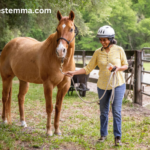Horses, with their powerful presence and graceful demeanor, have long been companions and partners in human civilization. Their journey from wild creatures roaming the steppes to domesticated animals that revolutionized human societies is a tale of evolution, adaptation, and deep interspecies relationships. This article explores the history and evolution of horses, tracing their majestic journey through time. Explore the world of horse racing with France Cheval Turf. Get the latest news, tips, and insights to enhance your betting experience.
The Dawn of the Equine Lineage
The story of horses begins around 55 million years ago with a small, dog-sized creature known as Eohippus or “dawn horse.” Eohippus inhabited the lush forests of North America and had four toes on its front feet and three on its hind feet, adaptations suited for a life of browsing on soft, leafy vegetation. Over millions of years, climate changes led to the spread of grasslands, prompting the evolution of new equine species better adapted to open terrains.
By the Miocene epoch, around 20 million years ago, the genus Merychippus had emerged. Merychippus was larger and had developed a more efficient grazing mechanism, including high-crowned teeth better suited for grinding grass. This period marked a significant transition from browsing to grazing, a pivotal adaptation in the evolution of horses.
The Rise of Modern Horses
The modern horse, Equus, appeared around 4 to 5 million years ago during the Pliocene epoch. Equus was well-adapted to the expanding grasslands of North America with its single-toed hooves and elongated limbs, which allowed for efficient long-distance travel and escape from predators. As climate changes and geological events altered the landscape, Equus species migrated across land bridges to other continents.
During the Ice Age, horses thrived in various parts of the world, including Europe, Asia, and Africa. However, around 10,000 years ago, horses became extinct in North America, likely due to a combination of climate change and overhunting by early human inhabitants.
Domestication: A Turning Point
The domestication of horses marked a revolutionary chapter in their history and human civilization. Evidence suggests that horses were first domesticated on the steppes of Central Asia, particularly in present-day Ukraine, southwest Russia, and west Kazakhstan, around 4,000 to 3,500 BCE. The Botai culture is credited with some of the earliest evidence of horse domestication, including horse corrals and bridling.
Domesticated horses transformed human societies. They provided unprecedented mobility, enabling the expansion of trade networks, the spread of cultures, and the establishment of vast empires. Horses were used for transportation, agriculture, and warfare, fundamentally altering the dynamics of human history.
Breeds and Roles Through History
As horses spread across the globe, they were selectively bred for various purposes, leading to a diversity of breeds with specialized traits. The Arabian horse, known for its endurance and speed, became the foundation for many modern breeds. The sturdy and robust draft horses were bred for heavy labor, while lighter, agile horses were developed for riding and warfare.
Throughout history, horses have played crucial roles in numerous cultures. In ancient Egypt, they were symbols of power and prestige. In medieval Europe, knights rode into battle on powerful warhorses. The American West was shaped by the horse, with mustangs and quarter horses becoming iconic symbols of freedom and exploration.
The Modern Era: Horses in Contemporary Society
In today’s world, horses continue to hold a special place in human society. While they are no longer essential for transportation or agriculture, they remain vital in various recreational and therapeutic roles. Equestrian sports, such as dressage, show jumping, and racing, celebrate the athleticism and grace of horses. Therapeutic riding programs utilize horses to help individuals with physical, emotional, and developmental challenges.
Moreover, horses are cherished companions, forging deep bonds with their human caretakers. The relationship between humans and horses, built on mutual respect and trust, highlights the enduring connection that has evolved over millennia.
Conclusion
The history and evolution of horses are a testament to their resilience, adaptability, and profound impact on human civilization. From their origins as small forest dwellers to their current roles as beloved companions and athletes, horses have journeyed through time, leaving an indelible mark on our world. Understanding their majestic journey enriches our appreciation for these magnificent creatures and the timeless bond we share with them.









